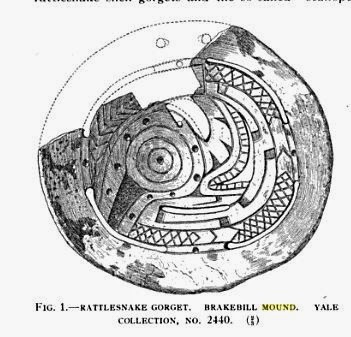View Larger Map
Some of the stone implements and shell
gorgets in the collection at Harvard were taken out of the mound in
September 1869 The following December the mound was opened by its
owner Adam Brakebill. At about this time and subsequently Dunning
conducted his excavations at the mound the dimensions of which he
gave as 20 feet high by 102 feet in diameter. Records giving details
of his excavation here and the association of the various objects
found are far from complete. Aside from a rusty sword blade of steel
found by the side of a human skeleton there is nothing in the Yale
collection from the Brakebill mound that would point to European
contact.
Bone and Antler
Bone and antler were not used extensively for either practical or
ornamental purposes. An exceptionally fine spatulate implement of
bone fig 14 is in the Harvard collection. It is cut from the central
portion of the shaft and is not only well preserved but also is
complete. The decoration consisting of series of parallel transverse
incised lines is simple and effective. A hole through one wall near
the base serves as a means of suspension. In the Yale collection is
another of the same type but with fewer incised lines half the blade
is missing There are several bone bodkins pointed at both ends. One
such was wrapped by a cord that left permanent markings some of which
have eaten into the bone fig 15. A pointed implement of deer antler is
reproduced in figure 16.
Shell: The
most notable objects of shell are the gorgets of which Dunning in one
of his letters says six were discovered in various parts of the
Brakebill mound at a depth of eight feet and under layers of charcoal
and burnt clay several yards square. Some of them were deposited
under the head of a human skeleton which was doubled up in the usual
manner ie sharply flexed arms and legs. The smallest of the engraved
shells was under the skull of a youth another near a male skeleton of
mature age and with it a large polished ax of greenstone, some
delicately shaped flint arrow points and a carved representation in
shell of a human face.
Stone: Stone
was employed in ways ornamental as well as practical. The boat amulet
seen in figure 17 might have been employed as a sort of button In
shape it is not unlike the head of a bird facing two ways. A boat
amulet similar in shape was found forty years ago at Silver Lane near
Hartford Connecticut.
Pottery: The
paste contains so much pulverized shell as to give a pronounced
reaction when treated to hydrochloric acid. Moreover the shell
component is distinctly visible by contrast with the darker clay Very
few of the vessels are whole. A plain vase without handles and one
with a pair of handles and shoulder ornament in relief are reproduced
in figure 21 Judging from the thickness and curvature of some of the
sherds vessels of large size were in use at the Brakebill mound.
Among the many sherds one is selected for illustration because of the
rim decoration and the curious stamped design on the body of the
vessel fig 22 A small potsherd disc is reproduced in figure 23.
Excerpts from Proceedings, edited by
Frederick Webb Hodge. Read the whole book here: Link











No comments:
Post a Comment